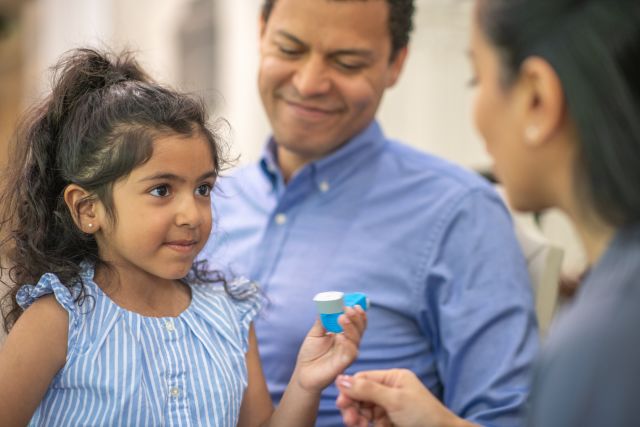Updated on August 25, 2023
If your child has asthma, you may already know the challenges it can pose in daily life. Asthma can keep you up at night, listening to your child’s breathing. It can disrupt school, work, and travel routines. It can also make it harder for kids to learn and play—and leave them worried about when their next exacerbation might come.
The fact is, this chronic lung condition complicates life for many families. But with the right information, it is possible to gain confidence and feel in control. Here are three essential facts that all families living with childhood asthma should know about, plus steps you can take to help support a loved one with this condition.
Asthma can look different in kids
If you know an adult who has asthma—or you’ve seen it depicted on TV—you might think of “typical” symptoms like shortness of breath, coughing, and wheezing (a loud type of breathing). While kids do experience these symptoms, especially during an asthma attack, some asthma signs can be more subtle in kids.
Children don’t always know what they’re feeling or may not have the words to tell you when they’re short of breath. If their airways are tight, you might notice signs of discomfort and/or low oxygen instead. The following symptoms can signal trouble breathing and/or low oxygen levels in kids:
- Trouble sleeping
- Acting tired or sluggish
- Lack of interest in play or food
- Difficulty speaking
- Trouble eating, latching, or taking a bottle
- Mood swings, including being more clingy or irritable than usual
You might notice changes to children’s skin color as well, especially under the eyes, around the mouth, or on the beds of their fingernails. Kids with dark skin might look paler than usual or their skin may take on a “greyish” appearance. Those with olive or yellow skin tones might look greyish or “green.” Those with pale or pink tones might look “blueish” or paler than usual.
“If any of these symptoms appear, the child needs to be seen by a healthcare provider right away,” says Abby Mutic, PhD, MSN, CNM, Principal Investigator of the Southeast Pediatric Environmental Health Specialty Unit (PEHSU) at Emory University in Atlanta, Georgia. “With signs of severe distress—like gasping for air or difficulty speaking—call 911 or take them to the nearest emergency room immediately.”
Subtle, long-term signs of asthma that can go overlooked in kids are chronic runny or stuffy nose or itchy or watery eyes, adds Mutic. “Even obvious breathing problems can get blamed on preschool infections instead of asthma. With preschoolers, there’s often a hesitation to diagnose asthma because breathing problems at that age can be caused by many things.”
Although diagnosing asthma in very young children can be difficult, the benefits are great. Early diagnosis can lead to better treatments, which can help kids avoid serious illness.
Parents and caregivers can help children’s healthcare providers (HCPs) determine the right diagnosis by keeping a log of their kid’s symptoms. Doing so is simple: Take note of any new or unusual symptoms your child develops. Bring the log to their checkups, even if you're not sure if the symptoms are asthma-related.
Asthma is a leading cause of missed school
Asthma is one of the most common reasons kids miss school. The severity of a child’s asthma also affects their ability to:
- Think clearly and do well on tests
- Complete assignments on time
- Hand in quality work
- Earn good grades
- Make friends
- Graduate
The more asthma triggers there are in a child’s environment, the more likely they are to have severe asthma days and miss school. Complex factors related to environmental racism (more below) contribute to children of color experiencing more asthma-related absences than white children. Children of color are also less likely to have a plan in place to manage asthma flare-ups. Reasons for this can include kids not having access to a school nurse and bias among healthcare providers.
All kids with asthma need an asthma action plan. This is a document that should be made with your child’s HCP and updated each year. It details exactly what to do (which medications to give, phone numbers to call, and steps to take) for different asthma scenarios, including emergencies. Your child’s teachers, coaches, and caregivers should all have a copy.
Today, some schools are adopting school-level asthma action plans. School-level plans can involve protocols for protecting kids against asthma risks and responding to asthma emergencies. A school-level plan can be helpful—and lifesaving—in schools where many children have asthma but where not all students have access to proper asthma care.
“It’s important to think about health issues like asthma through a lens of empathy,” adds Mutic. “Looking around the room, there will always be someone who doesn’t have access to the same resources that you do.”
School-level plans can take into account cleaning practices, safe air policies, transportation offerings, and emergency protocols that can benefit large numbers of students. These plans should not replace, but rather strengthen, individual action plans.
Everyday environments impact asthma risk
Asthma symptoms are brought on when a person with asthma is exposed to triggers in the environment. Triggers can include things they’re allergic to, like fragrances, or things that cause airway inflammation, like car exhaust. In other words, the environments in which children live, learn, and play can affect whether they develop asthma and how severe their symptoms are.
In an ideal world, the systems that shape people’s environments, like housing and education, would keep kids and families safe. But that isn't always the case.
Instead, inequities in the way resources are shared throughout society can create environments that are hazardous for specific communities, particularly people of color. Any one societal structure (such as housing, transportation, health care, or education) can be biased against groups of people. Biases can also overlap, combine, and interact to harm kids and families in profound ways.
“This is called environmental racism,” says Mutic. “You can have two children from the same city or town, but their exposures to pollutants are very different based on the communities they’re from and the systems—like policy and law—that shape their environments. One child might have access to a clean park, eco-friendly housing, and a school nurse, for instance, and the other might not.”
These issues can seem overwhelming, but there are real things everyone can do to help protect kids and communities from environmental racism and environmental injustices:
Connect with your regional PEHSU
Each region in the United States has its own Pediatric Environmental Health Specialty Unit, or PEHSU. These government-sponsored networks bring together families, communities, physicians, nurses, scientists, and advocates to address major environmental issues in each part of the country.
Each PEHSU has a different focus based on regional needs. Some might be more involved in protecting kids against wildfire smoke, for example, while others are more active in reducing pollution in cities. All of them can serve as a resource for questions about keeping the places where kids live, learn, and play safe against asthma risks.
Visit the Pediatric Environmental Health Specialty Units home page and use their interactive map to find the regional PEHSU near you.
Get involved in your community
Use the search tool available through USA.gov to contact your local, state, and federal officials when environmental issues threaten communities. Offices count and catalogue the messages they receive. The more messages they get, the more likely they are to act. What’s more, you can get to know your representatives at the city and county level to share your concerns and ideas directly.
Vote in local, state, and national elections
Local elections are often overlooked, even when they stand to have the most immediate effects on families and communities. Mark your calendar for local elections and research the candidates ahead of time so you can know where they stand on environmental issues.
“When caregivers, healthcare providers, teachers, and school administrators work together to address asthma on a broader scale,” Mutic says, “we can help keep the air cleaner, reduce disease risk, and ensure effective emergency responses for everyone.”
This article has been written in collaboration with the Center for Children’s Health Assessment, Research Translation, and Combating Environmental Racism (CHARTER) at Emory University. CHARTER works to develop strategies to translate research findings on children’s environmental health for stakeholders in the community, academia, and health care with the goal of improving children’s health.





